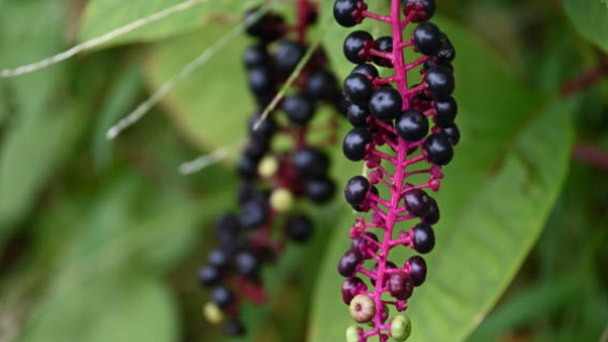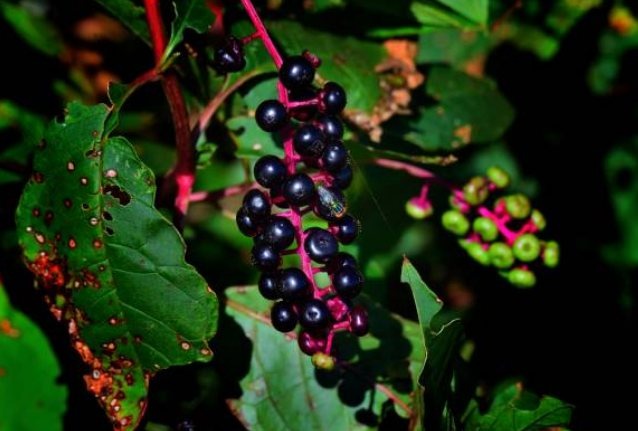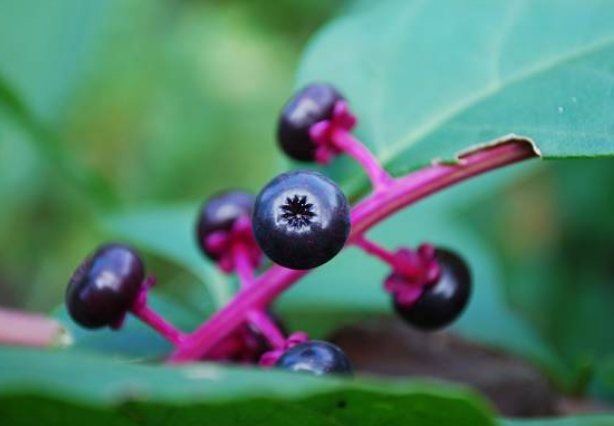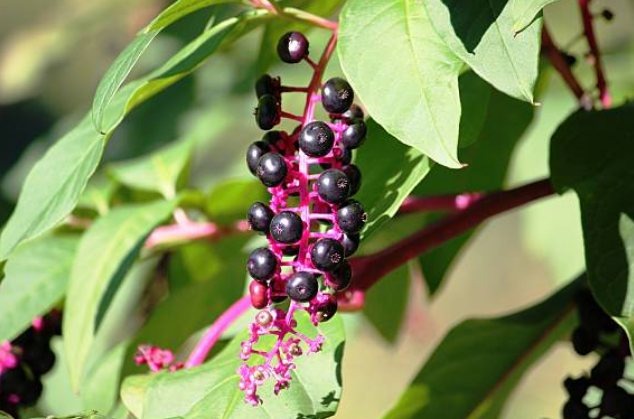Is Pokeweed Poisonous To Touch - What You Should Know
Written by Ivy
Jan 06 2023

Particularly when the sap comes into contact with bare skin, pokeweed is poisonous to both humans and animals, including pets and livestock.
You will learn more about pokeweed in this article, along with safe handling techniques.
What is Pokeweed?

Pokeweed is a troublesome weed that is typically present throughout North America, so you might be all too familiar with it. But before discovering its toxicity, we must get to know it a little better.
Let's take a look at the basics:
| Pokeweed | Specification |
| Species | Phytolacca Americana |
| Habitat | Across North America |
| Life span | 40 years, perennial |
| Toxicity | To mammals |
Pokeweed has a very distinct appearance and can develop into a small bush or a tall tree, making it simple to identify when it appears in your garden.
These plants have a maximum height of 10 feet! They have long, broad leaves, stems that are vivid red or purple, and dark purple berries that are borne in clusters. Additionally, in the spring and summer, they produce teeny white flowers.
Pokeweed prefers temperate climates despite their long lifespan. The top of the pokeweed bush will die off in the winter in order to protect itself. Afterward, it will grow once more, begin to bear fruit, and bloom when springtime arrives.
Strangely enough, the shoots and leaves are edible for a brief period in the spring and early summer before they mature and turn toxic. They can be included in salads and even stews in the same way that collard greens are. If you are not a professional or have received assurance that it is the appropriate season, we do not advise trying this as it may result in fatal circumstances.
Pokeweed is a traditional medicine used by Native Americans that stimulates the heart and can be used to treat certain cancers. A method for safely utilizing pokeweed in treatments has been handed down through many generations.
Pokeweed can be remarkably tenacious because they spread their seeds using birds. The seeds are dispersed through the bird droppings after the birds eat the berries. The result may be that numerous bushes start to appear in various areas of your garden.
Is It Safe to Touch Pokeweed?
Pokeweed is poisonous to the touch because the toxins can enter the bloodstream through the skin and cause problems with the respiratory system, the digestive system, and the skin.
These phytolaccine proteins may be taken up by the body when coming into contact with the plant's juices, such as those found in berries, roots, or cut stems. starting a chain reaction of harm to the digestive and respiratory systems. The touching of the leaves has also been widely reported to cause rashes and other skin irritations (similar to poison ivy).
Yes, centuries ago, it was quite normal to drink brewed pokeweed tea. And you will occasionally see some forums that say "Sure! Pokeweed is edible and relatively safe." But there is no doubt that we have a reason to keep scrolling in light of established scientific research and the experiences of regular people like you and me.
It is strongly advised that you wear protective clothing when trying to get rid of this plant so that none of the sap doesn't get on your skin. It is best to acknowledge its unique and colorful appearance (from a distance) if you come across it, say, while out on a nature hike, and then carry on with your journey.
Poisoning Symptoms After Touching Pokeweed
When a plant or plant product containing the aforementioned toxic proteins is consumed accidentally or on purpose, it is referred to as pokeweed poisoning. Additionally, both prescribed and over-the-counter medicines may interact negatively with these. which might cause unpleasant side effects. There are particular symptoms to watch for that may signify poisoning if there has been prolonged skin exposure or ingestion.
A hemorrhagic loosening of the bowels, stomach pain, nausea, and vomiting are a few symptoms of the GI tract that may appear within 2–6 hours. Low blood pressure, convulsions, headaches, and muscle spasms can all be side effects of blood exposure. However, problems with the respiratory system could lead to breathing difficulties, weakness, and even unconsciousness.
Is Pokeweed a Skin Irritant?
Yes, skin problems brought on by contact with this toxic plant have been treated in a large number of people and animals. While not as common as poison ivy, some cases can be more severe than others depending on a person's sensitivity to it. If exposed, toxins can enter the bloodstream through the skin and cause a variety of unfavorable symptoms.
Therefore, it is highly advised that you wear rubber gloves and protective clothing when handling it if you are unsure of your personal tolerance for it. Skin exposure can result in mild cases that can be treated at home. like you would poison oak or ivy. Consult a doctor right away if the situation is more serious.
Does Touching Pokeweed Cause a Rash?
It has been widely reported that people have experienced skin rashes and inflammation. Gardeners and landscapers experience an odd itch just as they are enjoying the glow of a job well done. From four hours to ten days after exposure, this can occur.
The skin reacts to oils in pokeweed leaves in a similar way to poison ivy, causing mild cases to frequently resemble blotchy, prickling discolorations or small hives. However, if the skin comes into contact with the plant's root, stem, or berry juices, more severe cases could arise. In these situations, blisters that spread readily. especially if a skin wound that is already present is exposed.
Increased Or Decreased Heart Rate
An irregular heartbeat is one alarming sign of pokeweed exposure or consumption. Toxins cause blood vessels to constrict, either increasing or decreasing. This causes the heart rate to slow down and the blood pressure to drop. An elevated heart rate results from the heart having to work harder to maintain adequate blood flow as the exposed person moves around.
Seizures
Recall the "chain reaction" I alluded to earlier? Here's one instance: when ingesting pokeweed's phytolaccine protein results in a sharp drop in blood pressure, which subsequently causes breathing problems and cardiac distress. Due to the brain's lack of oxygen caused by this type of respiratory insufficiency, seizures are a potential side effect of ingesting pokeweed.
Muscle Spasms
Muscle spasms would be the following link in that chain. By lowering blood pressure and causing blood vessels to close, toxins deprive muscles of the blood-producing spasms they so desperately need.

How to Treat Pokeweed Poisoning After Touching
The majority of the time, a mild rash can be treated at home. the same way you would soothe the itch of chicken pox, poison ivy, or oak. Attempt to refrain from scratching, however difficult. Because doing so will only help the toxin that is causing the rash to spread. Seek immediate medical attention if the rash spreads or if you experience any other symptoms.
The itch may be reduced by using a topical hydrocortisone ointment available over the counter. Anything containing benzocaine or an antihistamine should be avoided because they may make the situation worse.
First Aid for Pokeweed Poisoning
Mild cases typically get better in a few days with the aid of over-the-counter anti-itch creams and non-steroidal painkillers. But once more, if any of the more serious symptoms mentioned should appear, taking a few thoughtful actions will help you recover healthily.
- Make an immediate call for nearby emergency assistance.
- Give them as much information as you can (amount and time of exposure or ingestion and general health status of affected person)
- Unless instructed by a healthcare professional, DO NOT induce vomiting in the affected individual
- Try to take a sample of what was ingested or touched for the medical professional to inspect
How Do You Get Rid of Pokeweed Rash?
To help absorb and wash away any toxins, wash your hands with cool water and a mild disinfectant soap. A lukewarm bath is also effective if the irritation covers larger areas of the body.
Inflammation brought on by the pokeweed rash can be reduced by applying cool compresses to the skin. The uncomfortable tingling sensation can be reduced and you won't have to scratch it thanks to topical anti-itch ointments. Scratching might result in more skin tears and a subsequent infection.
Normal self-resolution occurs in mild cases. However, more severe cases should be handled as a healthcare professional advises.
What Part of Pokeweed is Poisonous for Humans to Touch?
A pokeweed plant's entire body is filled with phytolacca toxin and phytolaccigenin proteins. This implies that every root, stem, leaf, and berry carries a risk. However, the degree of toxicity will differ based on the plant part in question and the plant's actual age. Let's examine each of them more closely.
Pokeweed Roots
The greatest amount of toxic biochemicals are found in the roots of pokeweed plants. Care must be taken when attempting to remove this plant from the soil because doing so from the roots is the only practical way to eradicate it entirely from your property.
Pokeweed trees and shrubs are intentionally left on some properties because some people find their aesthetic appeal appealing. It is not advised to do this, though, for health and safety reasons. especially if you live with small children and pets.
The entire taproot must be taken out of small pokeweed plants in order to remove them. Small fragments left behind will only sprout new plants. Small shoots can be removed by hand or with a weed puller while wearing protective gear, just like a carrot.
Dig a large circle around the plant that you think would include the entire root ball for larger shrubs and trees. Put on protective clothing once more and delve deep into the ground to get rid of the big taproot. Continue until all roots have been eliminated and properly disposed of.
Pokeweed Berries
People throughout human history (even today) have been enticed to eat wild pokeweed berries by their juicy, colorful appearance. Much to the detriment of their internal organs. Berries contain bio-toxins in liquid form which means they can travel quickly throughout the body and do some serious damage.
If you're considering removing a flowering pokeberry, wearing rubber gloves, you'll want to remove the flowers and berries first. Before they drop and are allowed to germinate. One plant can produce tens of thousands of seeds that can remain viable in the soil for 40 years.
Pokeweed Leaves & Stems
Pokeweed's toxic oils could potentially seep into your skin and affect your blood if you handle the leaves and stems with bare hands. At best, causing a nasty, itchy rash. At worst, you spending some time in the emergency room.
Wearing elbow-length rubber gloves is recommended when pruning or removing this plant. Moreover, small children and dogs are often attracted to this plant by its color and foliage. Children touching the leaves and stems and then touching their faces could prove dangerous. Dogs or other animals could also experience fatal symptoms when ingesting pokeweed leaves or stems.
Pokeweed Seeds
Seeds from pokeweed berries give us a very convincing second reason why to steer clear of them. Not only does the berry itself contain poisonous juice but the seeds within are almost as concentrated with toxins as the roots. All the more reason to remove these first, before removing the plant from your property.
Causes of Pokeweed Poisoning
Every part of the pokeweed plant contains toxic phytolacca toxin and phytolaccigenin proteins. Rendering every root, stem, leaf, and berry as potentially poisonous. The most severe pokeweed poisoning events occur when any part of this plant is ingested. Whether intentionally or accidentally.
Always research different plants and shrubs that you plan to remove from your property for safety and protection. Many poisonings occur when plants are assumed to be benign when they are in fact highly toxic. You can find out all about how to get rid of pokeweed by reading my article here.
What Happens If You Touch Pokeweed?
Simply touching pokeweed roots, stems, leaves or berries can provoke an allergic reaction. Very similar to poison oak or ivy. More mild cases happen when the berry juice or plant sap comes in contact with the skin.
Exposure to its toxic proteins can cause an inflamed, blister-like rash. Or worse, be absorbed into the bloodstream through the skin, causing a wide range of internal issues. Unless you've been tested, you won't know whether or not you have a tolerance for this plant. So, it's best to protect yourself when handling it or simply steer clear.
What Happens If You Ingest Pokeweed?
Eating any part of a pokeweed plant can be hazardous to your health. Eating just 10 small berries (green or red) can result in nausea, severe stomach pain, vomiting, and incontinence.
Upon entering the bloodstream, pokeweed constricts blood vessels resulting in a drop in blood pressure. Especially affecting those on antihypertensive drugs like ACE inhibitors, beta-blockers, and diuretics. More than that can cause cardiac issues, seizures, and even death.

What Happens If You Eat Pokeweed?
So now that you know that even a touch could be harmful, we wanted to add in an additional warning about what can happen if the pokeweed is consumed rather than just touched, just in case the worst-case scenario occurs.
Consuming the leaves, stem, leaves, or root of the pokeweed can cause many concerning symptoms:
- Violent vomiting
- Muscle spasms
- Rapid pulse
- Diarrhea
- Headache
- Low blood pressure
- Loss of consciousness
- Death
Pokeweed toxicity will affect any mammal, so both you, you children and any of your pets will be vulnerable to pokeweed toxicity. If you even suspect that a human or pet has eaten pokeweed, you should rinse out the area and get them medical attention as soon as possible.
Is Pokeweed Poisonous to Touch FAQs
Can Pokeweed Kill You?
Pokeweed contains highly toxic proteins called phytolaccatoxin and phytolaccigenin. Ingesting them can cause a wide range of symptoms, like irregular heartbeat, low blood pressure, and oxygen deprivation. Symptoms that if left untreated could result in death.
What Does Pokeweed Do to Your Blood?
Once pokeweed toxins enter the bloodstream, they can cause blood vessels to constrict. Blocking the pathways by which vital oxygen reaches different parts of the body. This can lead to shortness of breath, weakness, seizures, and heart problems.
Conclusion
When pokeweed rears its purple head, it can be a nasty pest to deal with, but it is possible to handle safely if you follow our guidance.
The main takeaway from this is that pokeweed is poisonous to the touch and highly toxic when consumed.
We recommend only handling pokeweed with gloved hands and pulling it from your garden as soon as possible. We hope this guide has helped you avoid any nasty rashes in the future.
Latest Updated
- Benefits of Bugleweed - 7 Science-backed Health Benefits
- Bugleweed Dangers & Side Effects - Is It Poisonous?
- How to Plant Evergreen Trees - What You Should Know
- When to Plant Evergreens - Grow Guide for Evergreen Trees
- 12 Wonderful Evergreen Shrubs for Your Garden
- 12 Popular Evergreen Plants with Pictures for Beginners
- When And How To Prune A Lilac Bush Like a Pro
- How to Grow & Care for Lilac Vine (Hardenbergia Violacea)
- Japanese Lilac Tree (Syringa Reticulata) Care & Propagation Guide
- Shumard Oak Pros and Cons - What to Know
Popular Articles
- Winter maintenance of Antirrhinum Majus
- How to Grow Terminalia Mantaly Tree
- How to Grow and Care for Crossostephium Chinense
- How to grow Antirrhinum Majus in spring
- Peristeria Elata (Dove Orchid) Profile: Info & Care Guide
- Underwatered Snake Plant (Sansevieria Trifasciata) - Signs And How To Fix
- How to Care for Brazilian Jasmine Plant (Mandevilla Sanderi)
- How to Grow & Care for Graptopetalum Purple Delight in Summer
- Rosa Chinensis (China Rose): Plant Growing & Care Tips
- How to Care for Baby Sun Rose (Aptenia Cordifolia)